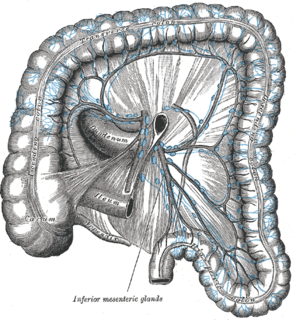Lymphadenectomy or lymph node dissection is the surgical removal of one or more groups of lymph nodes. It is almost always performed as part of the surgical management of cancer. In a regional lymph node dissection, some of the lymph nodes in the tumor area are removed; in a radical lymph node dissection, most or all of the lymph nodes in the tumor area are removed.
Lumpectomy is a surgical removal of a discrete portion or "lump" of breast tissue, usually in the treatment of a malignant tumor or breast cancer. It is considered a viable breast conservation therapy, as the amount of tissue removed is limited compared to a full-breast mastectomy, and thus may have physical and emotional advantages over more disfiguring treatment. Sometimes a lumpectomy may be used to either confirm or rule out that cancer has actually been detected. A lumpectomy is usually recommended to patients whose cancer has been detected early and who do not have enlarged tumors. Although a lumpectomy is used to allow for most of the breast to remain intact, the procedure may result in adverse affects that can include sensitivity and result in scar tissue, pain, and possible disfiguration of the breast if the lump taken out is significant. According to National Comprehensive Cancer Network guidelines, lumpectomy may be performed for ductal carcinoma in situ (DCIS), invasive ductal carcinoma, or other conditions.
ALMANAC is the name of a major breast cancer trial. The acronym stands for "Axillary Lymphatic Mapping Against Nodal Axillary Clearance." This major randomized trial performed in several centres in the UK produced clear evidence that sentinel node biopsy (SNB), used to stage axillary spread of disease, can be used with low failed localization and false negative rates, provided both radioisotope and blue dye are used to locate the sentinel nodes.
The sentinel lymph node is the hypothetical first lymph node or group of nodes draining a cancer. In case of established cancerous dissemination it is postulated that the sentinel lymph node/s is/are the target organs primarily reached by metastasizing cancer cells from the tumor.

Radical mastectomy is a surgical procedure involving the removal of breast, underlying chest muscle, and lymph nodes of the axilla as a treatment for breast cancer. Breast cancer is the most common cancer among women today, and is primarily treated by surgery, particularly during the early twentieth century when the mastectomy was developed with success. However, with the advancement of technology and surgical skills, the extent of mastectomies has been reduced. Less invasive mastectomies are employed today in comparison to those in the past. Nowadays, a combination of radiotherapy and breast conserving mastectomy are employed to optimize treatment.

The axillary lymph nodes or armpit lymph nodes drain lymph vessels from the lateral quadrants of the breast, the superficial lymph vessels from thin walls of the chest and the abdomen above the level of the navel, and the vessels from the upper limb. They are divided in several groups according to their location in the armpit. These lymph nodes are clinically significant in breast cancer, and metastases from the breast to the axillary lymph nodes are considered in the staging of the disease.

The inferior mesenteric lymph nodes consist of:
A brachial lymph nodes are group of four to six lymph nodes which lies in relation to the medial and posterior aspects of the axillary vein; the afferents of these glands drain the whole arm with the exception of that portion whose vessels accompany the cephalic vein.

Supraclavicular lymph nodes are lymph nodes found superior to the clavicle, palpable in the supraclavicular fossa. The supraclavicular lymph nodes on the left side are called Virchow's nodes.
A micrometastasis is a small collection of cancer cells that has been shed from the original tumor and spread to another part of the body through the lymphovascular system. Micrometastases are too few, in size and quantity, to be picked up in a screening or diagnostic test, and therefore cannot be seen with imaging tests such as a mammogram, MRI, ultrasound, PET, or CT scans. These migrant cancer cells may group together to form a second tumor, which is so small that it can only be seen under a microscope. Approximately ninety percent of people who die from cancer die from metastatic disease, since these cells are so challenging to detect. It is important for these cancer cells to be treated immediately after discovery, in order to prevent the relapse and the likely death of the patient.
Rotter's lymph nodes are small interpectoral lymph nodes located between the pectoralis major and pectoralis minor muscles. They receive lymphatic fluid from the muscles and the mammary gland, and deliver lymphatic fluid to the axillary lymphatic plexus. These lymph nodes are susceptible to breast cancer, as the cancer sometimes spreads (metastasizes) to the interpectoral lymph nodes. Rotter's lymph nodes are named after German surgeon Josef Rotter (1857-1924), who described them in the early 19th century.
The AJCC staging system is a classification system developed by the American Joint Committee on Cancer for describing the extent of disease progression in cancer patients. It utilizes in part the TNM scoring system: Tumor size, Lymph Nodes affected, Metastases.
A medial supraclavicular lymph node is a lymph node located above the collar bone and between the center of the body and a line drawn through the nipple to the shoulder.
A mediastinoscope is a thin, tube-like instrument used to examine the tissues and lymph nodes in the area between the lungs (mediastinum) in a procedure known as mediastinoscopy. These tissues include the heart and its large blood vessels, trachea, esophagus, and bronchi. The mediastinoscope has a light and a lens for viewing and may also have a tool to remove tissue. It is inserted into the chest through a cut above the breastbone.

Gliosarcoma is a rare type of glioma, a cancer of the brain that comes from glial, or supportive, brain cells, as opposed to the neural brain cells. Gliosarcoma is a malignant cancer, and is defined as a glioblastoma consisting of gliomatous and sarcomatous components.
Precursor T-lymphoblastic lymphoma is a type of non-Hodgkin lymphoma in which too many T-cell lymphoblasts are found in the lymph nodes and spleen. Also called T-lymphoblastic lymphoma, it is most common in young men.

Male breast cancer is a rare cancer in males that originates from the breast. Many males with breast cancer have inherited a BRCA mutation, but there are other causes, including alcohol abuse and exposure to certain hormones and ionizing radiation.

Lymphovascular invasion is the invasion of a cancer to the blood vessels and/or lymphatics.










